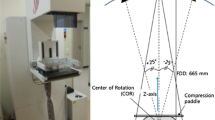Abstract
In order to justify the clinical use of a new modality such as digital breast tomosynthesis (DBT), a performance test in terms of a clinical parameter is indicated. For screening applications, lesion detectability is crucial. Whereas a real phantom with typically a homogeneous background that includes a series of details may provide a good indication of such detectability, a more specific approach is needed if the potential advantages of DBT have to be assessed. More specifically, the potential of the reduction of soft tissue superposition has to be covered in the performance test. We propose 2 concepts for a performance evaluation phantom: a hardware phantom with lesion-like inserts and where a background can be simulated on top of the images, and a software phantom with simulated lesions of different size and density (that can originate from theoretical models or from attenuation templates of real lesions). We discuss the need and the use of these phantoms for performance testing.
Access this chapter
Tax calculation will be finalised at checkout
Purchases are for personal use only
Preview
Unable to display preview. Download preview PDF.
Similar content being viewed by others
References
Niklason, L.T., Christian, B.T., Niklason, L.E., Kopans, D.B., Castleberry, D.E., Opsahl-Ong, B.H., Landberg, C.E., Slanetz, P.J., Giardino, A.A., Moore, R., Albagli, D., DeJule, M.C., Fitzgerald, P.F., Fobare, D.F., Giambattista, B.W., Kwasnick, R.F., Liu, J., Lubowski, S.J., Possin, G.E., Richotte, J.F., Wei, C.Y., Wirth, R.F.: Digital Tomosynthesis in Breast Imaging. Radiology 205, 399–406 (1997)
Burgess, A.E., Jacobson, F.L., Judy, P.F.: Human observer detection experiments with mammograms and power-law noise. Med. Phys. 28, 419–437 (2001)
EC (European Commission) 2006 European guidelines for quality assurance in breast cancer screening and diagnosis, 4th edn. European Commission, Brussels (2006)
Mertelmeier, T., Orman, J., Haerer, W., Dudam, M.K.: Optimizing filtered backprojection reconstruction for a breast tomosynthesis prototype device. In: Medical Imaging 2006: Physics of Medical Imaging, Proceedings of SPIE, vol. 6142, pp. 61420F-1–61420F-12 (2006)
Bakic, P.R., Albert, M., Brzakovic, D., Maidment, A.D.A.: Mammogram synthesis using a 3D simulation I. Breast tissue model and image acquisition simulation. Med. Phys. 29, 2131–2139 (2002)
Bliznakova, K., Bliznakov, Z., Bravou, V., Kolitsi, Z., Pallikarakis, N.: A three-dimensional breast software phantom for mammography simulation. Phys. Med. Biol. 48, 3699–3719 (2003)
Smans, K., Carton, A.K., Zoetelief, J., Verbrugge, B., Haek, W., Struelens, L., Vanhavere, F., Bosmans, H.: Med. Phys. Simulation of image detectors in radiology for determination of scatter-to-primary ratios using Monte Carlo radiation transport code MCNP/MCNPX. Accepted for publication in Med. Phys
Tward, D.J., Siewerdsen, J.H.: Cascaded systems analysis of the 3D noise transfer characteristics of flat-panel cone-beam CT. Med. Phys. 35, 5510–5529 (2008)
Shaheen, E., Van Ongeval, C., Cockmartin, L., Zanca, F., Marshall, N., Jacobs, J., Bosmans, H.: Realistic Simulation of Microcalcifications in Breast Tomosynthesis. In: IWDM (2010)
Author information
Authors and Affiliations
Editor information
Editors and Affiliations
Rights and permissions
Copyright information
© 2010 Springer-Verlag Berlin Heidelberg
About this paper
Cite this paper
Bosmans, H. et al. (2010). Performance Assessment of Breast Tomosynthesis Systems: Concepts for Two Types of Phantoms. In: Martí, J., Oliver, A., Freixenet, J., Martí, R. (eds) Digital Mammography. IWDM 2010. Lecture Notes in Computer Science, vol 6136. Springer, Berlin, Heidelberg. https://doi.org/10.1007/978-3-642-13666-5_31
Download citation
DOI: https://doi.org/10.1007/978-3-642-13666-5_31
Publisher Name: Springer, Berlin, Heidelberg
Print ISBN: 978-3-642-13665-8
Online ISBN: 978-3-642-13666-5
eBook Packages: Computer ScienceComputer Science (R0)



